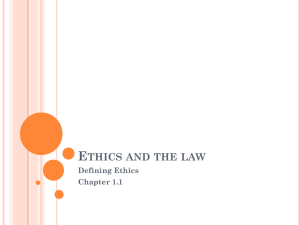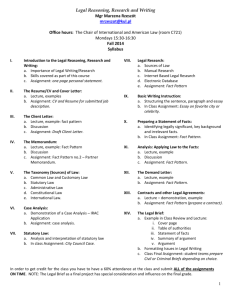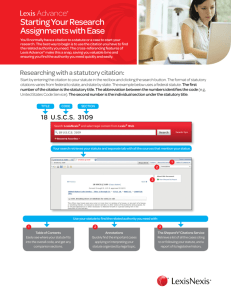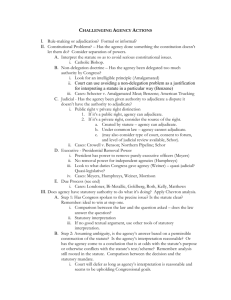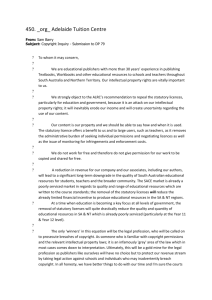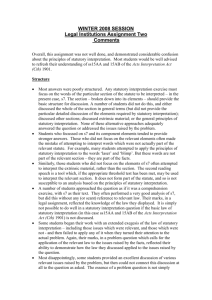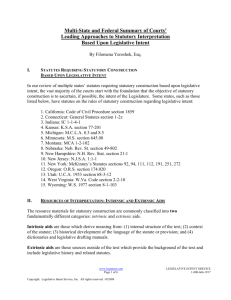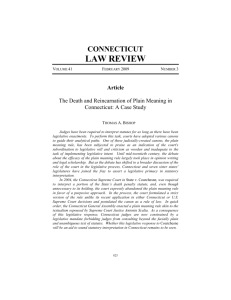Determining Legislative Intent & Rules of Statutory
advertisement
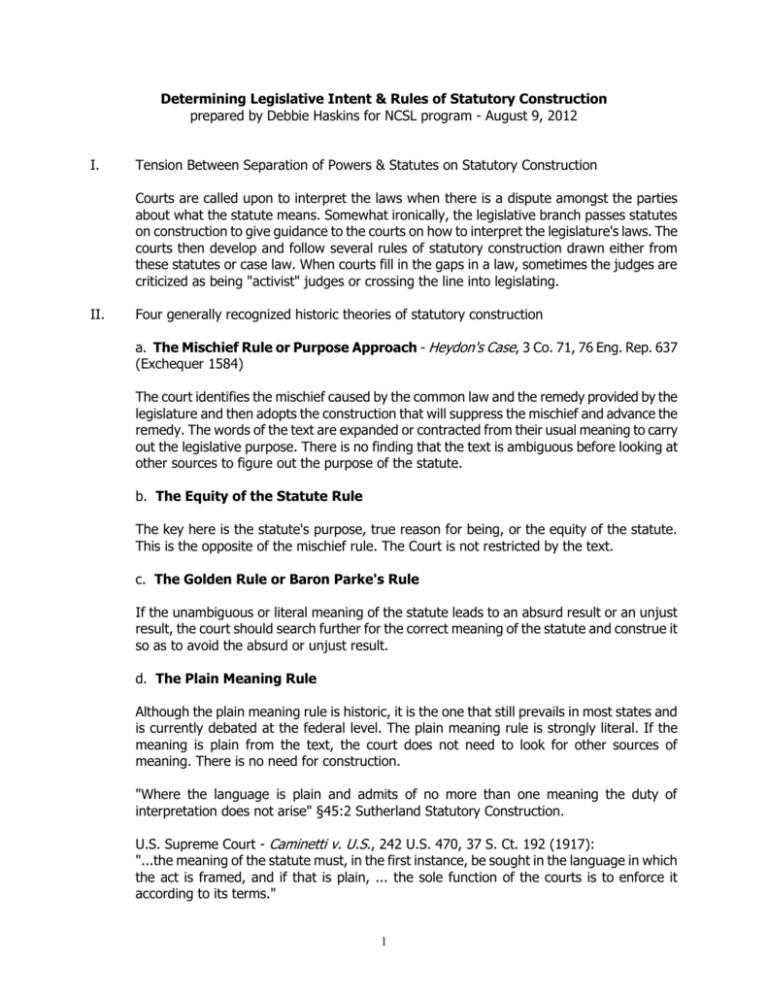
Determining Legislative Intent & Rules of Statutory Construction prepared by Debbie Haskins for NCSL program - August 9, 2012 I. Tension Between Separation of Powers & Statutes on Statutory Construction Courts are called upon to interpret the laws when there is a dispute amongst the parties about what the statute means. Somewhat ironically, the legislative branch passes statutes on construction to give guidance to the courts on how to interpret the legislature's laws. The courts then develop and follow several rules of statutory construction drawn either from these statutes or case law. When courts fill in the gaps in a law, sometimes the judges are criticized as being "activist" judges or crossing the line into legislating. II. Four generally recognized historic theories of statutory construction a. The Mischief Rule or Purpose Approach - Heydon's Case, 3 Co. 71, 76 Eng. Rep. 637 (Exchequer 1584) The court identifies the mischief caused by the common law and the remedy provided by the legislature and then adopts the construction that will suppress the mischief and advance the remedy. The words of the text are expanded or contracted from their usual meaning to carry out the legislative purpose. There is no finding that the text is ambiguous before looking at other sources to figure out the purpose of the statute. b. The Equity of the Statute Rule The key here is the statute's purpose, true reason for being, or the equity of the statute. This is the opposite of the mischief rule. The Court is not restricted by the text. c. The Golden Rule or Baron Parke's Rule If the unambiguous or literal meaning of the statute leads to an absurd result or an unjust result, the court should search further for the correct meaning of the statute and construe it so as to avoid the absurd or unjust result. d. The Plain Meaning Rule Although the plain meaning rule is historic, it is the one that still prevails in most states and is currently debated at the federal level. The plain meaning rule is strongly literal. If the meaning is plain from the text, the court does not need to look for other sources of meaning. There is no need for construction. "Where the language is plain and admits of no more than one meaning the duty of interpretation does not arise" §45:2 Sutherland Statutory Construction. U.S. Supreme Court - Caminetti v. U.S., 242 U.S. 470, 37 S. Ct. 192 (1917): "...the meaning of the statute must, in the first instance, be sought in the language in which the act is framed, and if that is plain, ... the sole function of the courts is to enforce it according to its terms." 1 Basically under the plain meaning rule, if you can determine the plain meaning, you don't have to resort to rules of statutory construction. Corollary rule: "In the absence of a specific indication to the contrary, words in the statutes will be given their common, ordinary and accepted meaning, and the plain language of the statute should be afforded its plain meaning." U.S. v. Lehman, 225 F. 3d 426 (4th Circ. 2000). Corollary rule: If the statute is ambiguous, then the court will look to rules of statutory construction. And there are many, many rules of statutory construction, including that the court can look at and consider: • • • • • • • • the object sought to be attained the circumstances under which the statute was enacted the legislative history, if any the legislative intent the consequences of a particular construction (i.e., what could happen? - would it result in an absurd result? would it result in an impossible task?) the legislative declaration or purpose laws upon a similar subject the administrative construction Key issue - is there ambiguity? Ambiguity exists when a statute is capable of being understood by reasonably well-informed persons in two or more different senses. §45:2 Sutherland Statutory Construction III. There is a lot of criticism that the plain meaning approach can be result-oriented. A court may or may not find ambiguity depending on the result it desires. And if you look at the long list of rules of statutory construction, it's pretty easy to conclude that the court can find a rule of statutory construction to support its conclusion. NCCUSL: "Most state courts claim that they follow the plain meaning rule, although it has many formulations and is often stated differently in opinions of the same court....it has often been used to frustrate the apparent intent of the legislature.... That appellate courts often divide almost equally as to whether a particular text is ambiguous has furthered doubts about the way this approach is used. Another criticism is that the strict plain meaning rule requires a court to make a threshold finding of the existence of an ambiguity before all the information that the court needs to make an informed judgment is presented to it." NCCUSL, 1995 Act, p. 24 IV. Statutes on Statutory Construction a. Colorado Revised Statutes on construction of words and phrases and construction of statutes. Colorado is an example of the plain meaning approach. b. Colorado's statutes are based on the Uniform Statutory Construction Act of 1965 of the National Conference of Commissioners on Uniform State Laws (NCCUSL). Only 3 states (Colorado, Iowa, and Wisconsin) adopted substantially all of that act; however, according to the NCCUSL web site many of the model act's provisions are found in the statutes of over 43 2 other states. c. NCCUSL further revised the act in 1995 (Uniform Statute and Rule Construction Act). 1995 NCCUSL version has only been enacted by New Mexico. Two significant differences between first model act and the new model act: Plain meaning analysis v. step by step approach Step by Step: 1) primacy of the text, 2) look to model rules on statutory construction, including presumptions to give effect to the statute's objective and purpose, give effect to entire text, and avoid an unconstitutional, absurd, or unachievable result 3) Determine if the statute is uncertain? If so, then you can look to intrinsic aids, including legislative history Look to intrinsic aids if ambiguous v. uncertain V. Typical Case using a Plain Meaning Analysis: People v. Miller, 97 P.3d 171 (Colo. App. 2003). VII. Current Writing and Thinking About Statutory Construction a. If you judged by the numerous law review articles currently available on this topic, you would conclude that the status of the law is very unsettled. In fact, at the federal level and in the legal academic fields, the issue of statutory interpretation is very unsettled. b. Comments to the Uniform Statute and Rule Construction Act (1995) by NCCUSL: "A particular theory of construction is not adopted, by this Act, ...because of the state of the law on statutory construction and, in part, because "...American courts have no intelligible, generally accepted and consistently applied theory of statutory construction." quoting Henry M. Hart, Jr., and Albert M. Sacks... A careful review of state court opinions discloses that the rules of statutory construction are not rules in the same sense as are other rules of law, such as the rule imposing strict liability on a manufacturer of goods. It is not clear whether this status of the law is due to the basic inadequacy and contradictory nature of the many and often contradictory rules of statutory construction, the imprecision of language, the inclination of some to start with the answer instead of the question, other factors, or some combination of these factors." (p. 23, Uniform Statute and Rule Construction Act (1995) ) c. Current Debate - Textualists v. Intentionalists The plain meaning advocates (textualists) insist on confining construction to the plain import of the words. The intentionalists or purpose adherents insist on the intention or purpose of the statute. Main Textualists: Justice Antonin Scalia and writing expert Bryan Garner. They just wrote a 567 page book on Textualism entitled Reading Law: The Interpretation of Legal Texts. "We look for meaning in the governing texts, ascribe to that text the meaning that it has borne from its inception, and reject judicial speculation about both the drafter's extratextually derived purposes and the desirability of the fair 3 reading's anticipated consequences". Intentionalist: Judge Richard Posner - Posner advocates "putting the construer in the shoes of those who enacted the statute to find out how they would have resolved the problem, especially as to a situation apparently overlooked by the statute." NCCUSL, comments to 1995 Act, p. 25 If you are interested in learning more about the different theories, see Phillip Frickey, From the Big Sleep to the Big Heat: the Revival of Theory in Statutory Interpretation, 77 Minn. L. Rev. 241, (1992) VII. Closing Remarks Despite all the debate, the appellate courts in your state have probably actually developed an approach to these kinds of cases. Look to your state statute first, then see what case law has developed over time. 4


